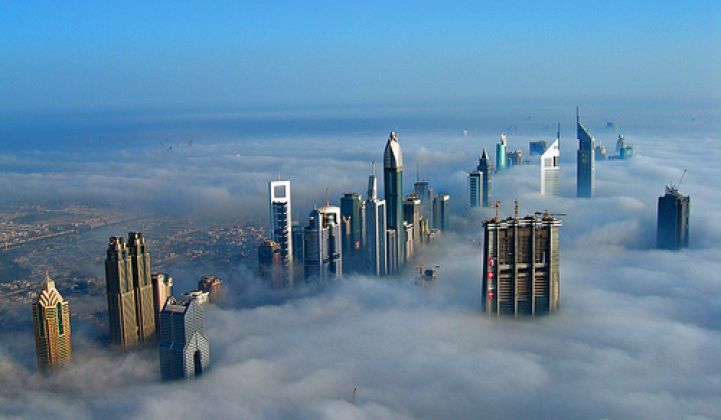The World Future Energy Summit, or WFES, is a massive annual conference in Abu Dhabi highlighting cleantech in the Middle East and internationally. The event is as high profile as any, with an estimated 30,000 attendees in 2013 and speakers like Wen Jiabao and Ban Ki-moon in 2012 and Francois Holland in 2013.
It seems that many things in the United Arab Emirates are world’s biggest, largest, or first. The UAE is home to the world’s tallest building and the world’s fifth highest carbon dioxide emissions per capita. However, under the patronage of Masdar, Abu Dhabi will be home to the world’s largest single-unit concentrating solar power plant when the Shams-1 facility is complete in the first quarter of 2013.
In fact, the emirate of Abu Dhabi has set a goal of meeting 7 percent of its peak electricity demand from renewable energy by 2020, amounting to roughly 1,600 megawatts. To accomplish this, the Abu Dhabi government established Masdar. Masdar is described by Dr. Steven Griffiths, Executive Director of Institute Initiatives at Masdar Institute and Research Director at the Emirates Solar Industry Association, as “a commercially driven company investing in and developing renewable energy and clean technology; a graduate-level university focused on clean energy and sustainability; and a sustainable urban development.”
However, given the region’s propensity for high-profile events and proclamations and a historically cavalier attitude toward carbon usage, it is not surprising that many in the cleantech industry are asking the question, “Is all of the UAE’s talk about ‘future energy’ real?”
There are certainly a number of points one could make that would indicate otherwise; for years, Abu Dhabi supported rampant construction of massive energy-inefficient buildings, and the government continues to support fossil-fuel subsidies that encourage unchecked usage of oil and electricity. Others could point to the fact that there is less than 40 megawatts of installed PV capacity in the UAE and Saudi Arabia combined, according to GTM Research.
Perhaps the most effective way to curb carbon emissions would be to cut fossil fuel subsidies, but efforts to do so in other countries have led to significant social turmoil. Instead, the Abu Dhabi government has decided to institute minimum building efficiency codes and work to decrease the carbon intensity of its electricity generators by diversifying its energy mix.
In addition to the Shams-1 plant, Masdar has invested in the world’s largest offshore wind farm in the London Array, and the world’s first commercially operational CSP plant with molten salt energy storage. Masdar’s sustainable city development, Masdar City, will be home to an international agency dedicated to the development and deployment of renewable energy policy, the International Renewable Energy Agency. Perhaps more importantly, Masdar’s presence in the city of Abu Dhabi is a constant reminder to the citizens that while energy may be cheap, it doesn’t come without consequences. Abu Dhabi has shown leadership regionally, and was the first nation in the Middle East and North Africa (MENA) region to build a large scale PV plant, the 10-megawatt Masdar City plant. Other nations such as Qatar and Saudi Arabia have launched their own programs, and the collective movement of the MENA nations could make a significant impact internationally.
The question remains, why is Abu Dhabi, the world’s fifth largest oil exporter and owner of the world’s seventh largest natural gas reserves interested in developing its renewable energy resources?
Abu Dhabi isn’t investing purely for its image; it’s also investing for energy security and human capital development. In 2007, Abu Dhabi became a net importer of natural gas. The UAE as a whole has struggled to meet its rapidly rising energy demand; indeed, power blackouts are not uncommon in the summer months. Developing the nation’s natural gas reserves has proven costly and difficult, as most gas is either sour or associated. Sour gas can be costly to process, and associated gas is limited by the rate of oil extraction.
Beyond these resource-related drivers, Abu Dhabi wishes to ensure that it is a leader in the energy world, not just in the oil and gas world. By creating Masdar, the government is developing the human capital in the UAE that will be necessary to drive growth in a carbon-restricted world. While the culture of excess in the UAE will ultimately need to change (there is a gold vending machine in the city’s premier hotel), Abu Dhabi is becoming a leader for sustainable development in the MENA region, and the nation’s billions of dollars invested are making a real impact.
For analysis on the opportunities and strategies for solar investment in the Middle East and North Africa, see GTM Research’s recent report produced in conjunction with the Emirates Solar Industry Association, The Middle East and North Africa Solar Market Outlook, 2013-2017.



